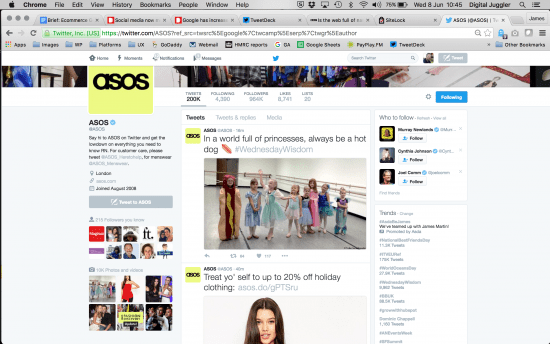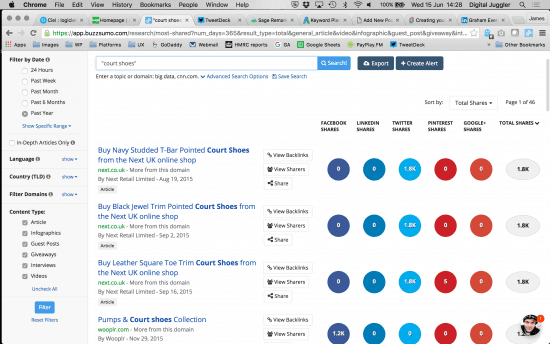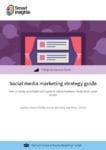Social media strategy and planning essentials series
This is part 6 of my Smart Insights 12 part social media series. In the last part we looked at the role of content in social media; in this blog, I discuss how social needs to work as part of your overall marketing plan, not in isolation.
The role of a marketing calendar
Most organisations have a marketing calendar that outlines the key campaigns for the year, typically broken down into monthly cycles. As with the content calendar, I discussed in the previous article, this helps define the big campaigns, the key messages, promotions, CTAs and the channels through which they will be delivered.
Social media needs to align with this calendar. Typically the most successful campaigns are executed across multiple channels simultaneously, promoting the same core message, albeit with a slightly different execution in each channel e.g. paid search campaigns typically use product and offer led CTAs but social posts are more conversational.
The marketing calendar is flexible and fluid, so it can change to allow the marketing team to respond to changing internal and external environments. There’s no point defining a campaign for 6 months’ time and then sticking to your guns even when the campaign is no longer relevant, or a competitor has trumped your promotion.
Using a calendar doesn’t preclude using social media to post custom content that isn’t part of these wider campaigns.
Download Paid Member Resource – Social Media Strategy Guide
Understand how to best use social media in your marketing strategy as an individual or as a business.
Access the Social media marketing strategy guide
You can. And you should.
An element of spontaneity is important to social media marketing, but always remember that there is (or should be) a set of guidelines that inform what and how you communicate. Don’t go off brand, or post content that’s at odds with your core marketing messages.

Tailoring marketing messages for social media
The marketing calendar gives you a campaign level plan; you then need to tweak the campaign assets to suit social networks.
Here are some examples…
Product campaigns:
- For new product launches, consider using product imagery to create new boards on Pinterest, Instagram photos etc.
- Use visual posts on Twitter rather than just text (you can add multiple pictures).
- Use animation to bring products to life e.g. gif images, short videos.
Events:
- Use photography to create engaging photos for visual networks like Instagram.
- Feature speaker interviews on your blog and then promote via Facebook posts, with speaker pictures.
- Add new events to Facebook and geo-tag the location
- Announce each event on Twitter with a link to the ‘about’ landing page
- Use the event or campaign hashtag in all posts (encourages others to use it + sharing amplifies reach).
Always ask yourself the following question: “how can we make campaign content interesting and relevant to our social audience?”.
Briefing social teams to handle campaign activity
Marketing campaigns create social conversations, even when the catalyst is another channel. For example, an offline ad can be shared by a user on a social network, which generates interactions with other users.
Do you have a process for briefing your social team for each campaign, even if social isn’t a core element?
If not, put one in place. Your social team needs to know what is happening, where, when and why. It needs to plan how it can take advantage of this campaign in the social space and ensure that someone is monitoring brand social channels and brand mentions.
If the social world is being critical, you need to listen, learn and respond. If your marketing is getting love, you need to encourage and reward it.
Social supporting organic marketing
Social and SEO should show each other love.
Why?
Social signals have long been part of search engine ranking algorithms, and recency is important. You should look at how key content and landing page URLs can be shared socially to amplify reach. This includes:
- Promoting new landing pages via social networks e.g. new product category, new brand range
- Posting links to latest content like blogs and videos.
SEO can also support social, by providing keyword data that can help social marketers understand what keywords people use to search and browse. This can help with copywriting for social posts, as well as for influencer research.
Let’s take the example of a shoe retailer. The SEO team flags to the social team that the search query “court shoes” is trending and there’s a new editorial landing page on the website with great content, including celebrity videos.
The social team can then use a social research tool like Buzzsumo to find out what content, and people, is most popular for this keyword. They can use this insight to work out what style of content would be of most interest to the social audience and identify relevant influencers to promote the content to. This can help generate new content that is tailored for the social audience, rather than relying on existing content.
It's also a useful feedback loop for the content and SEO teams, flagging what related content is getting the most shares. This can help tweak existing content or provide ideas for future content.

Your take away
Get your social and SEO teams working together to analyse content trends and share information to help inform plans.
Understanding the difference between paid social and paid search
First, it’s important to realise that paid social isn’t just an extension of your paid search campaigns; different audiences, different tools, different execution.
I know paid media specialists who’ve seen paid social campaigns fail because they simply replicate a paid search approach. There are a few similarities but we’re talking about push versus pull marketing; just because the two channels have the word “paid” in common it doesn’t mean the same approach works for each.
The similarities:
- You must put a lot of up-front effort into researching how to target your audience effectively
- You need to write targeted ad copy
- You need landing pages to best target social audiences
- You need to structure your campaigns that so that you show the right ads to the right people.
The difference
Paid Social is a highly accountable form of push marketing; you need to segment and structure your activity so that you can optimise for ROI using the data you generate, but there’s a different skill set required to that of a paid search practitioner in being able to research which groups of people are most likely to respond (totally different to KW research) AND knowing how to pitch to each segment through creative (slightly) less constraining than the PPC 25,35,35 text ad.
The key to effective paid social planning is blending the right resource. You need to roll in the expertise of planners, creative and biddable media experts. It’s not often that the core skill sets required belong to just one person, but the temptation for many is to lump it onto one person’s desk. The most important areas of expertise to have are:
“Planners can save themselves hours of time by talking to the client, and talking to customers – the people immersed in the subject matter are the ones who roll off the social media groups that target customers follow and the twitter accounts of the big influencers without even thinking about it.
Paid Social is much more intensive to manage to a high standard than Paid Search. Make sure you allocate enough man hours, and don’t shirk on the research and planning – success comes from finding the right social groups to target and developing a great pitch to use in your ads. Cutting corners on this process will mean your ROI is doomed from the start!”
Graham Everitt, freelance e-business consultant.
Social media ad tools offer a wide range of targeting and goal options, so it’s important to get to grips with the platforms you plan to use before starting your planning. Work out:
- Who and how you can target
- What types of ad you can test
- What content you can promote
- What CTAs you can push
- What measurement options there are
Paid social and search informing each other
Although they’re different, you should ensure they’re integrated. For example, you may already have spent a lot of time optimising paid search creative and landing pages, we can be used to inform paid search campaigns.
Your keyword data is full of useful insights. Apply your keyword learning to the social scene, and use these keywords to drive social keyword research. You will find some cross over and this can help save time in copywriting and ad optimization.
You can also make use of CRM data to help with social targeting by creating look alike audiences based on existing customer profiles. So customers acquired via other channels can help you build your audience profiles on social networks.
Your take away
Make sure the paid search and social teams talk to each other if it’s not done by the same people. Get them to share data, insights and plans.
Using social networks for event marketing
Above I outlined some ways use social media to promote events in the lead up to the event. Now let’s look at how you maximise social reach during and after the event. I’ve helped a few organisations create event social media marketing plans, and some simple activities can drive significant increases in social engagement.
Consider the following:
- During the event, remind people of the hashtag and encourage them to post live using the hashtag (needs good quality wifi!)
- Consider displaying a live hashtag wall (but don’t distract people from the talks!)
- Have your own live tweeter sharing key content, including speaker quotes and pictures from the event
- The day after, create a Storify thread for each event and share it while the event is fresh in people’s minds
- X days after the event, publish a blog write-up that shares key insights/learning and share this across all core social channels
- Publish videos of each speaker wherever possible (YouTube, Vimeo), then tweet each speaker the link to encourage them to share
- For attendees whose social IDs have been captured, send them a thank you message and link to event content, such as videos
- Use the event photos to create a Facebook album, add them to Instagram
- Contact key social influencers and share the event content with them – encourage them to share.
Your take away
Social media can extend the life of an event. Think about the content you can share to amplify the event reach and impact.
Appending social data to CRM contacts
Wouldn’t it be great to be able to deliver more personalized marketing to customers whose email addresses you have?
Well you can.
Using tools like Full Contact, you can upload customer email addresses and append social data, such as Twitter handles.
You can segment your audience to flag high-value customers and then deliver personalized 1-1 communication via social off the back of campaigns delivered in other channels. For example, your latest email has some killer deals, so you contact your top 100 customers via their social profiles 24hrs early to give them special access.
Yes you can do that via email but the alignment of CRM and social data enables a more personal style of communication.
And yes you can do that via paid social using the remarketing tools offered by platforms like Facebook. But by enriching your CRM database with customers’ social handles, you can build direct organic conversations.
Your thoughts, comments and personal experience
So this is step 6 in the Smart Insights 12 step series on social media strategy and planning.
Did you find it useful?
How important do you think it is to ensure social is aligned with other marketing channels in terms of campaign messaging and content? What tips and techniques can you share to help others?
Please join in the discussion and share your experience in the comments field at the bottom of this page.
Keep an eye out for next month’s article, “Resourcing for social media marketing”.
Missed the previous articles? Catch-up here:
- 6 reasons why you need a social media strategy
- How to create a social media strategy and plan
- Using competitor analysis to inform social media plans
- Understanding the role of organic and paid social media
- Role of content marketing in social media
Thanks
James

Thanks to
James Gurd for sharing his advice and opinions in this post. James is an experienced ecommerce and digital marketing consultant with more than 14 years’ B2C and B2B digital strategy and transformation experience. He is the Owner and lead consultant at
Digital Juggler. You can follow him on
Twitter or connect on
LinkedIn.






 Thanks to
Thanks to 


